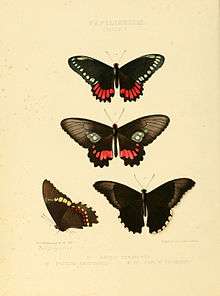Parides phosphorus
Parides phosphorus is a species of butterfly in the family Papilionidae. It is found in the Neotropical ecozone.
| Parides phosphorus | |
|---|---|
 | |
| Subspecies P. p. gratianus, figure 13 | |
| Scientific classification | |
| Kingdom: | |
| Phylum: | |
| Class: | |
| Order: | |
| Family: | |
| Genus: | |
| Species: | P. phosphorus |
| Binomial name | |
| Parides phosphorus (H.W. Bates, 1861) | |
| Synonyms | |
| |
The larvae feed on Aristolochia.
Subspecies
- P. p. phosphorus Guianas, eastern Venezuela, Brazil (Pará)
- P. p. gratianus (Hewitson, 1861) Colombia
- P. p. vavi Racheli, 1992
- P. p. zopyron Lamas, 1998 northern Peru
- P. p. laurae Bollino & Costa, 2004 southeastern Venezuela
Description from Seitz
P. phosphorus. Palpi red. Forewing somewhat transparent distally; male with dirty-green spot; hindwing rather strongly dentate, the red spots remote from the cell. Tibiae armed with spines, not thickened.Female with grey-green area on the forewing before the hindmargin, which occurs in no other female of the Aristolochia- Papilios. Colombia; Guiana; Lower Amazon; East Peru; perhaps more widety distributed. A rare insect; probably a swamp species which escapes observation. Two subspecies: — phosphorus Bates (3c) occurs in British Guiana and at the Lower Amazon. The green spot on the forewing of the male is narrow and separated from the cell. The forewing of the female has a row of 4 white spots on the grey-green area (always?). — gratianus Hew. (3 c) inhabits Colombia and East Peru. The green spot on the forewing of the male is much broader than in the preceding form; hindwing with only 3, or rarely 4, red spots, the series not curved. Forewing of the female with two white spots; the posterior spots of the hindwing large[1]
 'P. phosphorus phosphorus in Seitz
'P. phosphorus phosphorus in Seitz
Description from Rothschild and Jordan(1906)
A full description is provided by Rothschild, W. and Jordan, K. (1906)[2]
References
- Seitz, A. ed. Band 1: Abt. 1, Die Großschmetterlinge des palaearktischen Faunengebietes, Die palaearktischen Tagfalter, 1909, 379 Seiten,
mit 89 kolorierten Tafeln (3470 Figuren)

- Rothschild, W. and Jordan, K. (1906). A revision of the American Papilios. Novitates Zoologicae 13: 411-752. (Facsimile edition ed. P.H. Arnaud, 1967) and online
- Edwin Möhn, 2007 Butterflies of the World, Part 26: Papilionidae XIII. Parides Verlag Goecke & Evers Verlag Goecke & Evers ISBN 9783937783277
- Collins, N. Mark; Morris, Michael G. (1985). Threatened Swallowtail Butterflies of the World: The IUCN Red Data Book. Gland & Cambridge: IUCN. ISBN 978-2-88032-603-6 – via Biodiversity Heritage Library.
- Lewis, H. L., 1974 Butterflies of the World ISBN 0-245-52097-X Page 26, figure 20
- Edwin Möhn, 2006 Schmetterlinge der Erde, Butterflies of the World Part XXVI (26), Papilionidae XIII. Parides. Edited by Erich Bauer and Thomas Frankenbach Keltern: Goecke & Evers; Canterbury: Hillside Books. ISBN 978-3-937783-27-7 (Supplement 13 in English - by Racheli)
| Wikimedia Commons has media related to Parides phosphorus. |